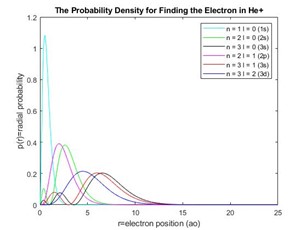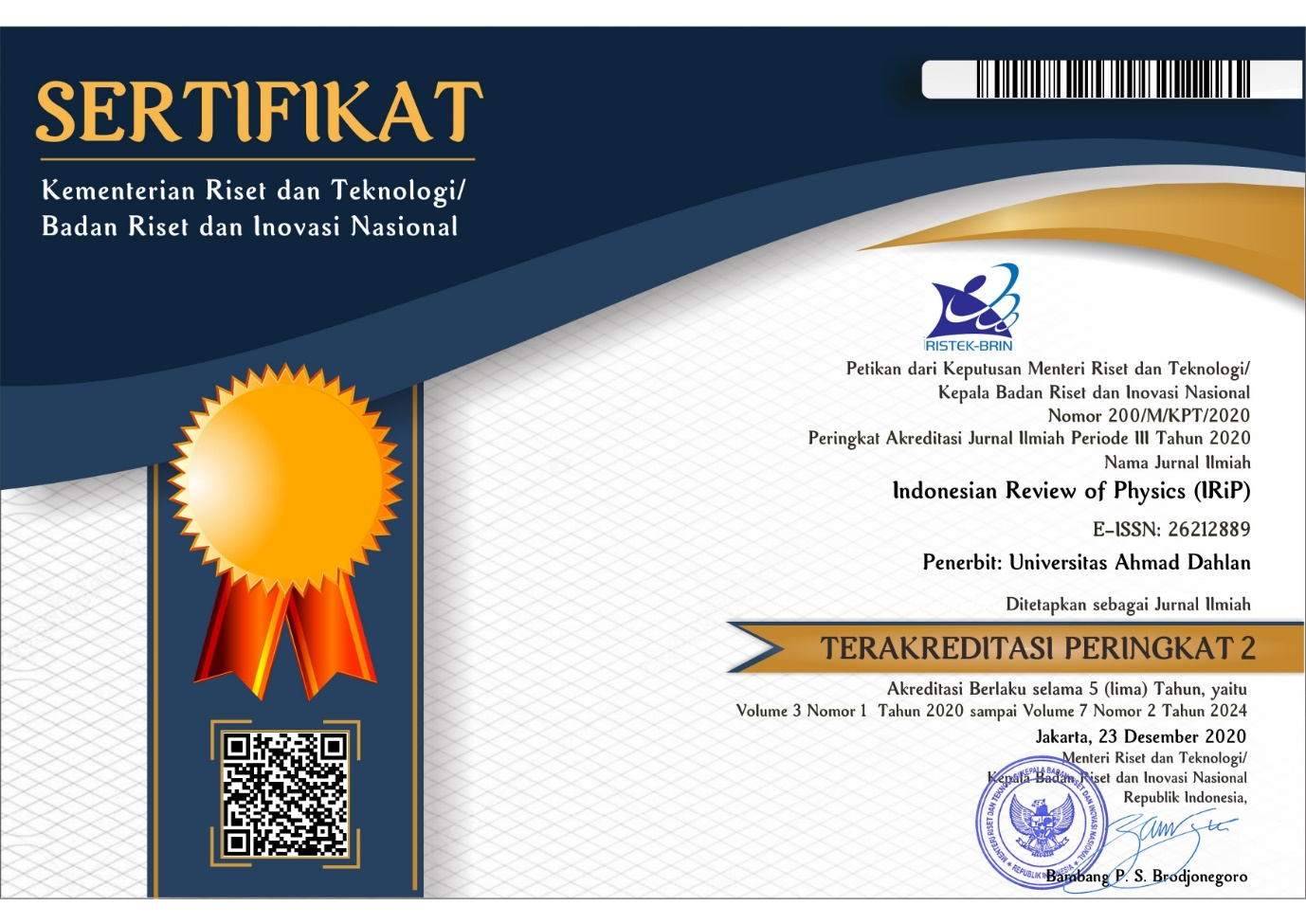Probability and Heisenberg Uncertainty of He+ at Quantum Numbers n≤3
DOI:
https://doi.org/10.12928/irip.v7i1.11939Keywords:
Helium Ion, Probability, UncertaintyAbstract
The purpose of this study is to analyze the probability and uncertainty of electron linear momentum in with the Heisenberg uncertainty approach. Measurement of the position and momentum of atomic electrons is probabilistic. The probability and uncertainty of electron linear momentum are analysed analytically, and simulations of hydrogenic atoms' normalized radial wave function are performed. they can be viewed as hydrogenic atoms with only one electron orbital. The probability and uncertainty of electron linear momentum in decrease with increasing values of the principal quantum number n ≤ 3. While the uncertainty of the electron position is increasing. The results of this study are in accordance with the characteristics of position and linear momentum that are not commutable. The increase in the value of the main quantum number means that the electron's position against this is getting farther, and the speed in the orbital is getting smaller.
References
K. S. Krane, Modern Physics, 3rd ed. New York: John Wiley & Sons, 2019.
V. Bezverkhniy, “Heisenberg’s Uncertainty Principle and Wave-Particle Dualism,” SSRN Electron. J., 2021, https://doi.org/10.2139/ssrn.3865301.
B. Supriadi, S. L. Lorensia, F. Shahira, A. M. Prabandari, and A. A. W. Putri, “Probability of Deuterium Atom Electrons in Momentum Space at Quantum Numbers n ≤ 3,” Aceh Int. J. Sci. Technol., vol. 12, no. 2, pp. 239–245, Aug. 2023, https://doi.org/10.13170/aijst.12.2.32226.
V. Christianto, “A Review of Schrödinger Equation & Classical Wave Equation,” Prespacetime J., vol. 5, no. 5, pp. 400–413, 2014, [Online]. Available: https://citeseerx.ist.psu.edu/document?repid=rep1&type=pdf&doi=cfd1cec7225098877108fcb9c6d8b7ebd758d0a6
B. Supriadi, A. Z. L. Kinanti, E. E. Putri, A. R. R, D. Natasha, and C. Sutantri, “Application of Laguerre Polynomial Equation In Solving Schrodinger Equation Radial Section of Helium Ion,” IOSR J. Appl. Phys., vol. 16, no. Series-1 (Jan. – Feb. 2024), pp. 22–31, 2024, https://doi.org/10.9790/4861-1601012231.
S. Dürr and G. Rempe, “Can wave–particle duality be based on the uncertainty relation?,” Am. J. Phys., vol. 68, no. 11, pp. 1021–1024, Nov. 2000, https://doi.org/10.1119/1.1285869.
G. Pandu, R. K. Pingak, A. Zicko Johannes, and Z. Seba Ngara, “A Study on Radial Properties of Hydrogenic Ions using Laguerre Polynomials,” Bul. Fis., vol. 23, no. 2, p. 78, Aug. 2021, https://doi.org/10.24843/BF.2022.v23.i02.p01.
B. Supriadi and L. Nuraini, Fisika Atom Teori & Aplikasinya. Jember: UPT Universitas Jember, 2019.
P. Borrelli and L. M, Helium Ion Microscopy: Principles and Applications. Cambridge University Press, 2020.
B. Supriadi, H. Mardhiana, W. I. Kristiawan, D. Kamalia, and I. K. Sari, “Expected Value of Helium Ion Electron Momentum in Momentum Space with Primary Quantum Numbers n≤3,” J. Penelit. Pendidik. IPA, vol. 9, no. 10, pp. 8467–8472, Oct. 2023, https://doi.org/10.29303/jppipa.v9i10.3861.
L. A. Alcalá Varilla, D. L. Pérez Pitalua, and F. Torres Hoyos, “Modeling a Helium Atom from a Collision of an Electron with an Ionized Helium Atom,” J. Phys. Conf. Ser., vol. 1386, no. 1, p. 012119, Nov. 2019, https://doi.org/10.1088/1742-6596/1386/1/012119.
E. Chappel, “Physical Properties of Helium and Application in Respiratory Care,” Encyclopedia, vol. 3, no. 4, pp. 1373–1386, Oct. 2023, https://doi.org/10.3390/encyclopedia3040098.
C. Rillo et al., “Enhancement of the Liquefaction Rate in Small-Scale Helium Liquefiers Working Near and Above the Critical Point,” Phys. Rev. Appl., vol. 3, no. 5, p. 051001, May 2015, https://doi.org/10.1103/PhysRevApplied.3.051001.
D. Li, J. Jiang, J. Wang, and Y. Jian, “Sputtering Behavior of Beryllium Materials Irradiated by Hydrogen-Helium Ions,” Nucl. Sci. Technol., vol. 07, no. 03, pp. 73–77, 2019, https://doi.org/10.12677/NST.2019.73010.
B. Supriadi, S. N. H. Anggraeni, M. K. K. Wardhany, F. A. Iswardani, N. A. Rosyidah, and D. Pangesti, “Probability of He+ Ion at Quantum Number 3 ≤ n ≤ 4 in Momentum Space,” J. Penelit. Pendidik. IPA, vol. 10, no. 5, pp. 2545–2551, May 2024, https://doi.org/10.29303/jppipa.v10i5.6458.
L. Subagiyo and A. Nuryadin, Pengantar Fisika Kuantum, 1st ed. Samarinda: Mulawarman University Press, 2018. [Online]. Available: https://repository.unmul.ac.id/handle/123456789/20722
B. Bhoja Poojary, “Origin of Heisenberg’s Uncertainty Principle,” Am. J. Mod. Phys., vol. 4, no. 4, pp. 203–211, 2015, https://doi.org/10.11648/j.ajmp.20150404.17.
D. J. Griffiths and D. F. Schroeter, Introduction to Quantum Mechanics. Cambridge University Press, 2018. https://doi.org/10.1017/9781316995433.
M. Halka and B. Nordstrom, Halogens and Noble Gases. 2010.
Z. Fitri, Kimia Unsur Golongan Utama, 1st ed. Syiah Kuala University Press, 2020. [Online]. Available: https://uskpress.usk.ac.id/product/kimia-unsur-golongan-utama-2/
M. S. Makmun, B. Supriadi, and T. Prihandono, “Fungsi Gelombang Ion Helium dalam Representasi Ruang Posisi Menggunakan Persamaan Schrodinger,” J. Pembelajaran Fis., vol. 9, no. 4, pp. 152–159, Dec. 2020, https://doi.org/10.19184/jpf.v9i4.19955.
A. R. Pratikha, B. Supriadi, and R. D. Handayani, “Electron’s Position Expectation Values and Energy Spectrum of Lithium Ion (Li^(2+)) on Principal Quantum Number n≤3,” J. Penelit. Pendidik. IPA, vol. 8, no. 1, pp. 252–256, Jan. 2022, https://doi.org/10.29303/jppipa.v8i1.840.
N. Sunarmi, “Distribusi Probabilitas Radial Elektron Sistem Molekul dalam Pengaruh Potensial Kratzer dengan Metode Parametrik Nikiforov-Uvarov,” J. Inov. Pendidik. dan Sains, vol. 4, no. 3, pp. 151–158, Dec. 2023, https://doi.org/10.51673/jips.v4i3.1794.
D. Bouaziz, “Kratzer’s Molecular Potential In Quantum Mechanics With A Generalized Uncertainty Principle,” Ann. Phys. (N. Y)., vol. 355, pp. 269–281, Apr. 2015, https://doi.org/10.1016/j.aop.2015.01.032.
B. Supriadi, T. Prihandono, V. Rizqiyah, Z. R. Ridlo, N. Faroh, and S. Andika, “Angular Momentum Operator Commutator Against Position and Hamiltonian of A Free Particle,” J. Phys. Conf. Ser., vol. 1211, p. 012051, Apr. 2019, https://doi.org/10.1088/1742-6596/1211/1/012051.

Downloads
Published
Issue
Section
License
Copyright (c) 2024 Bambang Supriadi, Zidan Afidah, Maya Arsita, Simatun Ni’mah, Merry Khanza Kusuma Wardhany, Moh Dimas Feri Hermansyah

This work is licensed under a Creative Commons Attribution-ShareAlike 4.0 International License.
Authors who publish in IRiP agree to the following terms: Authors retain copyright and grant the IRiP right of first publication with the work simultaneously licensed under a Creative Commons Attribution License (CC BY-SA 4.0) that allows others to share (copy and redistribute the material in any medium or format) and adapt (remix, transform, and build upon the material) the work for any purpose, even commercially with an acknowledgment of the work's authorship and initial publication in IRiP. Authors are able to enter into separate, additional contractual arrangements for the non-exclusive distribution of the journal's published version of the work (e.g., post it to an institutional repository or publish it in a book), with an acknowledgment of its initial publication in IRiP. Authors are permitted and encouraged to post their work online (e.g., in institutional repositories or on their website) prior to and during the submission process, as it can lead to productive exchanges, as well as earlier and greater citation of published work (See The Effect of Open Access).














